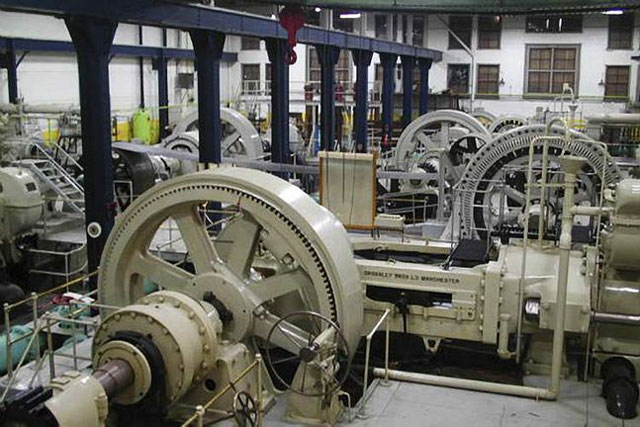In the spring of 1997, as a prairie ocean slowly formed around our city, we anxiously followed along as the provincial flood forecaster reported the rising water levels each day, describing it as 21, 22 or 23 feet above James. The term became a local catchphrase, but few people knew that "James" referred to the James Avenue Pumping Station, an unassuming little building along the Red River in the Exchange District.
As the waters receded, the spotlight dimmed and the building's last moments of fame faded away. A century earlier, however, the pumping station was one of the most important buildings in our growing young city. James Avenue Pumping Station.

In 1904, a great fire on Main Street threatened to destroy several blocks of downtown. To battle the blaze, the city was forced to release Assiniboine River water into the main lines. This contaminated the drinking supply and resulted in an outbreak of nearly 1,300 cases of typhoid throughout the city. In response, construction would soon begin on one of the most sophisticated high-pressure firefighting systems in the world. The only such facility in Canada and one of two in North America, it was such a wonder of engineering that in 1909, the British Science Association made the arduous journey across the globe to hold its annual general meeting in Winnipeg and tour the impressive new James Avenue Pumping Station, the centrepiece of the system.
Closed in 1986, the pumping station's elegant, rhythmic facade and double gable roofline serve as a reminder that the utilitarian building once stood as a pavilion in Victoria Park, Winnipeg's first municipal green space and ground zero for the 1919 General Strike.
Today, the pumping station finds itself in the centre of a neighbourhood that is being transformed more rapidly than any other part of downtown. Within a mere 100-metre radius of the handsome old structure, three new condominium buildings have been built, six historic warehouses are being converted to residential use, a new four-storey condominium and a spectacular boutique hotel are under construction and an eight-storey condominium and large parkade are proposed. In a few years, the area will not be recognizable from what it was a short time ago.
Even with this staggering amount of adjacent development, the pumping station today stands boarded up, abandoned and decaying. Its prime Waterfront Drive address contradicts the fact it likely holds the title of Winnipeg's most endangered heritage building.
Over the years, many proposals have come and gone for the James Avenue Pumping Station. It has been studied as a brew pub, a restaurant, a farmers market, a gallery and office space. Each time, construction costs have proven prohibitive.
Ironically, the greatest obstacle to the redevelopment of the pumping station is the element that makes it one of the most intriguing historic buildings in Winnipeg. Behind its heavy brick walls exists one of the most magnificent and least-known spaces in our city, a dramatic monument to a lost era.
With the floor five metres below the sidewalk, as you enter the pumping station, an unexpected grand volume opens in front of you. Below, a fantastic network of enormous cast-iron wheels and gears glistens in the light. Their remarkable scale inspires images of the Industrial Age a century ago. The grand machines proudly display the markings of their origin in Manchester, England, and look as if they could start up again with the flip of a switch.
The significant heritage asset of most buildings in the Exchange District is their character on the street, making their interiors easy to redevelop. The challenge of finding a new use for the pumping station is that without maintaining the inspiring industrial character of its interior, the historic value and redevelopment potential is lost. Effectively creating usable interior floor space while maintaining the building's unique character has been such a significant design challenge and economic barrier that the building has remained empty nearly two decades.
Buildings such as the pumping station are the reason the Exchange District is seeing such significant economic growth. The architectural character of the neighbourhood is an attractive catalyst to residential development, which makes its preservation critical to continuing prosperity in the area.
When looking at The Forks as a precedent, it is easy to appreciate that the site's spirit and character could only have been realized through the redevelopment of the existing industrial buildings. The Forks would not be the same had the old railway repair shops and storage buildings been demolished and replaced with new structures. Located in the middle of a burgeoning urban neighbourhood, a redeveloped pumping station holds similar potential to become a dynamic central focal point of its community and an attraction for the city as a whole.
Downtown Winnipeg flourished under the protection of the James Avenue Pumping Station. With a strong community vision and committed public leadership, it has all the potential to play a key role in the city's future as well. CentreVenture Development Corp. has been actively pursuing redevelopment for a long time, but as the building decays, the window of opportunity is closing. Soon, one of the great spaces in our city will be lost forever, before most Winnipeggers even have the opportunity to experience it.
Brent Bellamy is senior design architect for Number Ten Architectural Group.
Republished from the Winnipeg Free Press print edition July 9, 2012 B6

